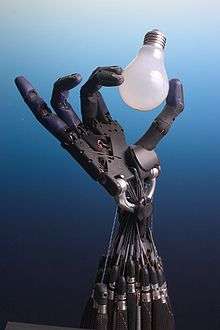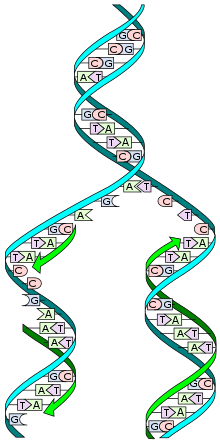Biorobotics
Biorobotics is a term that loosely covers the fields of cybernetics, bionics and even genetic engineering as a collective study.
Biorobotics is often used to refer to a real subfield of robotics: studying how to make robots that emulate or simulate living biological organisms mechanically or even chemically.
The term is also used in a reverse definition: making biological organisms as manipulatable and functional as robots, or making biological organisms as components of robots. In the latter sense, biorobotics can be referred to as a theoretical discipline of comprehensive genetic engineering in which organisms are created and designed by artificial means. The creation of life from non-living matter for example, would be biorobotics. The field is in its infancy and is sometimes known as synthetic biology or bionanotechnology.
In fiction, biorobotics makes many appearances, like the biots of the novel Rendezvous with Rama, the replicants of the film Blade Runner, or the bioroids of Appleseed/Ghost in the Shell universe.
Biorobotics in fiction
Biorobotics has made many appearances in works of fiction, often in the form of synthetic biological organisms.
The robots featured in Rossum's Universal Robots (the play that originally coined the term robot) are presented as synthetic biological entities closer to biological organisms than the mechanical objects that the term robot came to refer to. The replicants in the film Blade Runner are biological in nature: they are organisms of living tissue and cells created artificially. In the novel The Windup Girl by Paolo Bacigalupi, "windups" or "New People" are genetically engineered organisms.
The word biot, a portmanteau of "biological robot", was originally coined by Arthur C. Clarke in his 1972 novel Rendezvous with Rama. Biots are depicted as artificial biological organisms created to perform specific tasks on the space vessel Rama. This affects their physical attributes and cognitive abilities.
The 1968 East German novel Nabou by Günther Krupkat features an alien biorobot "Biomat".[1]
Humanoid Cylons in the 2004 television series Battlestar Galactica are another example of biological robots in fictions. Almost indistinguishable from humans, they are artificial creations created by mechanical cylons.
The authors of the Star Wars book series The New Jedi Order reprised the term biot. The Yuuzhan Vong uses the term to designate their biotechnology.
The term bioroid, or biological android, as also been used to designate artificial biological organisms, like in the manga Appleseed. In 1985 the animated Robotech television series popularized the term when it reused the term from the 1984 Japanese series The Super Dimension Cavalry Southern Cross. The term was also popularized in the 1988 computer game Snatcher, which features bioroids that kill, or "snatch", humans that they then take place of in society.
The term reploid, or replicate-android, is used in the Capcom video game series Mega Man X. Much like Blade Runner's replicants, these beings are more human in thinking and emotional awareness than previous generations, despite some being made into animal shapes to purposely distinguish them from humans. Another further future form of these robots, seen in Mega Man Zero, have them being so close to humans that they can actually eat, sleep, and reproduce. The only thing setting them apart is their semi-inorganic skeletal systems. In another farther flung future version and evolution of these bio-machines in the series Mega Man ZX humans and robots have merged seemingly so closely they are no longer a separate race but in-fact two parts to a whole new race. The final future of the game series is Mega Man Legends where humans and robots are one being to the point they can actually get together and reproduce offspring without effort.
In Warhammer 40k Imperium uses servitors, vat-grown humans with cybernetic parts replacing most parts of the body.They lack emotions or intelligence and are only capable of simple tasks. A more advanced imperial robots are used by the imperium; instead of using humans, they are mostly machine with a biological brain and other biological parts. Unlike servitors, they are capable of having programmed instincts for combat, but still they lack any true intelligence.
Practical experimentation
Orel V.E. invented the device of mechanochemiemission microbiorobotics. The phenomenon of mechanochemiemission is related to the processes interconversion of mechanical, chemical, electromagnetic energy in the mitochondria. Microbiorobot may be used for treatment of cancer patients.[2][3]
A biological brain, grown from cultured neurons which were originally separated, has been developed as the neurological entity subsequently embodied within a robot body by Kevin Warwick and his team at University of Reading. The brain receives input from sensors on the robot body and the resultant output from the brain provides the robot's only motor signals. The biological brain is the only brain of the robot.[4]
See also
References
- ↑ Fritzsche, Sonja (2006). Science Fiction Literature in East Germany. Oxford and New York: Lang. p. 114.
- ↑ Orel, V.E.; Zlobinskaya, O. (November 1999), "Mechanochemiemission microbiorobotic", Workshop Biomechanics meets Robotics Modelling and Simulation of Motion, Heidelberg, Germany, p. 50
- ↑ Orel, V.E. (1992), Editor-in-Chief:Kolyadenko, V.G., ed., "Concept of mehanochemiemission biorobotics", Proceeding. Actual problems of medicine and biology, Kyiv, Ukraine: Glushkov Institute of Cybernetics.The Academy of Sciences of Ukraine: 42–61
- ↑ Xydas, S.; Norcott, D.; Warwick, K.; Whalley, B.; Nasuto, S.; Becerra, V.; Hammond, M.; Downes, J. & Marshall (March 2008), Bruyninckx, Herman; Přeučil, Libor & Kulich, Miroslav, eds., "Architecture for Neuronal Cell Control of a Mobile Robot", European Robotics Symposium 2008, Springer Tracts in Advanced Robotics, Prague: Springer, 44, pp. 23–31, doi:10.1007/978-3-540-78317-6, ISBN 978-3-540-78315-2
External links
- Bioroïdes - A timeline of the popularization of the idea (in French)
- Harvard BioRobotics Laboratory, Harvard University
- Locomotion in Mechanical and Biological Systems (LIMBS) Laboratory, Johns Hopkins University
- BioRobotics Lab in Korea
- Laboratory of Biomedical Robotics and Biomicrosystems, Italy
- Tiny backpacks for cells (MIT News)
- Biologically Inspired Robotics Lab, Case Western Reserve University
- Bio-Robotics and Human Modeling Laboratory - Georgia Institute of Technology
- Biorobotics Laboratory at École Polytechnique Fédérale de Lausanne (Switzerland)
- BioRobotics Laboratory, Free University of Berlin (Germany)
- Biorobotics research group, Institute of Movement Science, CNRS/Aix-Marseille University (France)
- Center for Biorobotics, Tallinn University of Technology (Estonia)

